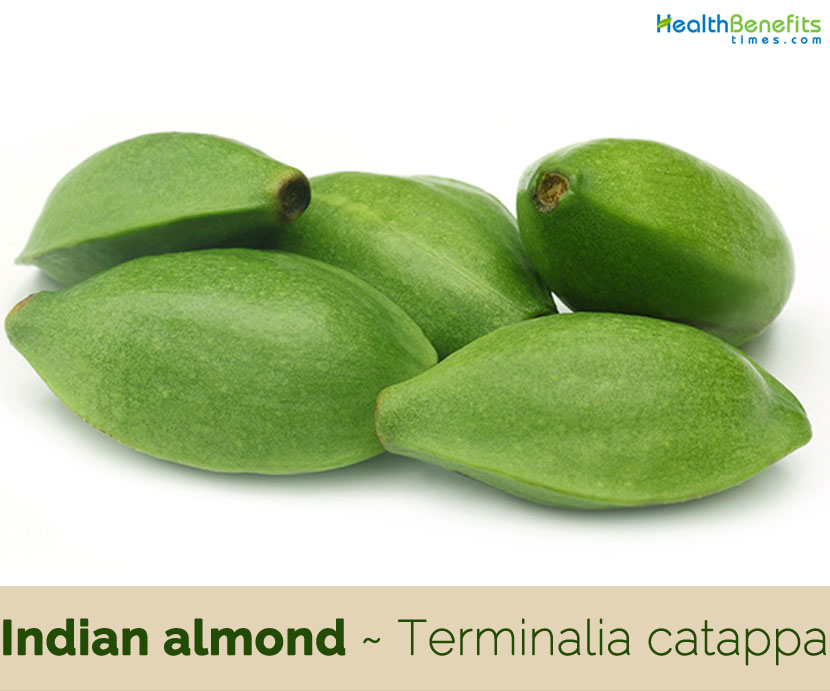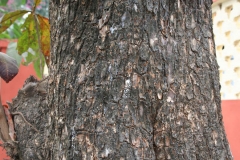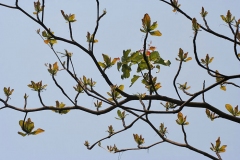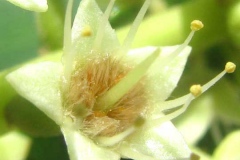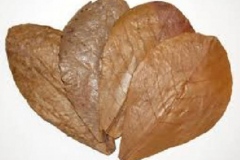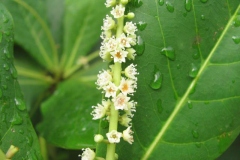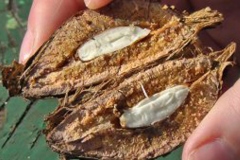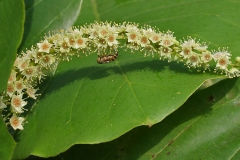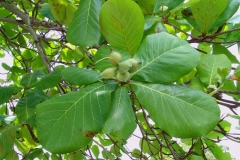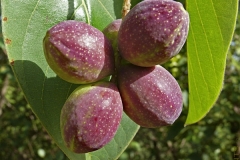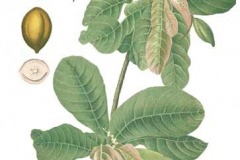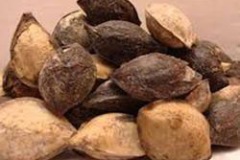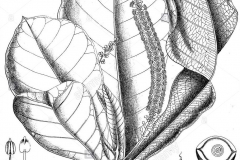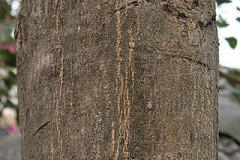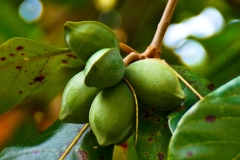| Indian almond Quick Facts | |
|---|---|
| Name: | Indian almond |
| Scientific Name: | Terminalia catappa |
| Origin | Indian subcontinent through southeast Asia, Northern Australia, New Guinea to the Pacific Islands |
| Colors | Green at first, then yellow and finally red or purplish when ripe |
| Shapes | Indehiscent, glabrous drupe 5–7 cm long by 3–5.5 cm broad, ellipsoid, somewhat compressed, narrowly winged along lateral margins |
| Flesh colors | Green |
| Taste | Sweet, acrid |
| Health benefits | Reduces Inflammation, Good for pregnant woman, Helps in Weight Loss, Promotes Healthy Bone, Improves Immune System, Promotes Brain Health, Prevents Constipation, Regulates Blood pressure, Regulates Blood Sugar Levels, Promotes a Healthy Heart, Prevents Cancer, |
| Leaf arrangement | Alternate |
| Leaf type | Simple |
| Leaf margin | Entire |
| Leaf shape | Broadly obovate |
| Leaf venation | Brachidodrome, pinnate |
| Leaf type and persistence | Deciduous |
| Leaf blade length | 4 to 15 inches |
| Leaf color | Dark green and shiny on top, paler green underneath |
| Fall color | Red, yellow, or purple |
| Fall characteristic | Showy |
Flowers
The flowers are small 4–6 mm (0.16–0.24 in) across, white or cream-colored, five-lobed, arranged on long 8–25 cm (3.2–10 in) axillary spikes, with a mildly unpleasant smell. Within a spike the majority of the flowers are male, with only a few bisexual flowers positioned toward the base. Each flower has a tiny 5-lobed calyx with 10 stamens and 1 style. Plants usually commence flowering and fruiting from a young age, e.g., within 2–3 years of out planting, but this varies with site and genotype. On highly fertile sites mature fruits have been collected from 18-month-old plants. Trees may refoliate and flower very soon (e.g., within 6 weeks) after being completely defoliated by cyclonic winds.
In Hawaii, Fiji, Vanuatu, and Tonga flowering and fruiting occur sporadically throughout much of the year. Flowering and fruiting of cultivated trees appears to be more synchronous in Vanuatu, where flowering peaks around October to January and is followed by fruiting around March to June.
| Flower color | Pale green or white |
| Flower characteristics | Not showy; star-shaped; emerges in terminal clusters on 2″–6″ long racemes |
| Flowering | Summer and fall |
Fruit
Normally one to five fruits develops on the basal part of the flower spike. Fruit is a sessile, laterally compressed, and ovoid to ovate, smooth-skinned drupe 5–7 cm long and 3–5.5 cm broad, ellipsoid, narrowly winged along lateral margins. During maturation, it changes its color from green through yellow to bright red or dark purplish-red at full maturity. The exocarp is shiny and coriaceous; the mesocarp is fleshy and fibrous and the endocarp is woody. The kernel consists of two delicate and complexly tangled cotyledons enclosed in an inconspicuous cream-colored, rarely red, testa. The rind of the fruit is a light, pithy, or corky tissue that enables the fruit to float and be dispersed by sea currents. The sea, bats, rodents, monkeys, and some large birds disperse the fruits. Each fruit consists of one single seed.
| Fruit shape | Elliptic |
| Fruit length | 2 to 3 inches |
| Fruit covering | Firm but fleshy drupe |
| Fruit color | Turns from green to red, yellow, or brown when ripe |
| Fruit characteristics | Does not attract wildlife; not showy; fruit/leaves a litter problem |
| Fruiting | Summer |
Seeds
Seed is enclosed by the fibrous endocarp. It is cylindrical-oblanceolate or cylindrical-elliptic and has a long funiculus. The seed coat is dull and whitish and is formed by the testa and tegmen. The embryo contained in the walnut-like fruit has a good flavor resembling the hazelnut. The period of seed viability is unknown.
History
Indian almond (Tropical almond) has a vast natural distribution in near coastal areas of the Indian Ocean, through tropical Asia, and into the Pacific Ocean. The extent to which its range has been increased through movement and dispersal by humans is difficult to determine. It extends from the Seychelles through India, the Andamans and adjacent islands, and throughout Southeast Asia (Myanmar, Thailand, the Malay Peninsula, Vietnam, the Philippines, and Indonesia) to Papua New Guinea and northern Australia as far south as the Tropic of Capricorn. The species is found throughout the South Pacific region, including the Solomon Islands, Vanuatu, and Fiji. It is present on nearly all the high archipelagos of Polynesia and Micronesia but may be an aboriginal introduction to the eastern parts of its current range (including all of eastern Polynesia).
Health benefits of Indian Almond
Indian almond consists of certain minerals which are very important to human health because they serve as co-factors for many metabolic processes in the body. These fruits contain several minerals and vitamins that perform important functions and add nutritional values which contribute positively to healthy living. Listed below are some of the popular health benefits of Indian almond
1. Reduces Inflammation
Seed of Indian almond fruit has an oil content that tends to reduce inflammation in the abdominal cavity. Almonds contain two very essential fatty acids which include linoleic and linolenic acids. These two fatty acids help in lowering inflammation all around the body. Fatty acid also aids in reducing LDL cholesterol level and they improve healthy skin and hair. Therefore consumption of almonds will contribute greatly to reducing inflammation in the entire body.
2. Good for pregnant woman
Indian almond consists of good amount of folic acid that helps to reduce the occurrence that can be dangerous for the babies such as of birth defects in newborn babies is very needed by pregnant women. So, for those of you who are pregnant, we strongly recommend you to make Indian almond as your snack from now on.
3. Helps in Weight Loss
Monounsaturated fat that is present in Indian almond aids in satisfying the appetite and reduces much eating. The dietary fiber found in Indian almond aids in keeping you full for a long time. Also, the fiber contained in it helps in consistent bowel movement which contributes to weight loss.
People who consume Indian almond regularly are more likely to maintain their ideal weight; therefore it is advisable that you consume Indian almond because it goes a long way in contributing to your weight loss.
4. Promotes Healthy Bone
Indian almond nuts are a rich source of dietary phosphorus, vitamins and minerals. Phosphorus plays an important role in bone formation and repair of cells in the body. Regular and moderate consumption of Indian almond helps in building a strong bone and teeth due to its richness in phosphorus and vitamins.
5. Improves Immune System
Research has shown that the Indian almond fruit consists of zinc and manganese which helps in the proper functioning of the immune system and metabolism of fat and carbohydrate among others.
Manganese and zinc which is an essential mineral necessary for the development, growth, and normal functioning of our bodies and for the immune system to function properly are contained in Indian almond which makes it a good fruit for your health.
6. Promotes Brain Health
Indian almond is a rich source of many nutrients that contribute to the proper development of the human brain. It is considered to be an essential food for growing children. This fruit contains two important brain nutrients such as L-carnitine and riboflavin, which helps greatly in increasing the brain activity, leading to new neural pathways and lowers the occurrence of Alzheimer’s disease. Research has proved that Indian almond in the diet and as oil is beneficial to the overall health and proper functioning of the nervous system.
7. Prevents Constipation
Indian almond is rich in fiber, which contributes a lot in preventing constipation. While consuming Indian almond, it is essential to drink water that will help to speed up the digestive process and the beneficial effects. The amount of fiber contained in 4 or 5 Indian almond is good enough for regulating of the bowel movements and digestive system. Regular consumption of Indian almond aids a lot in preventing constipation.
8. Regulates Blood pressure
Presence of potassium in Indian almond helps in blood pressure regulation and control of blood pressure fluctuation. Other numerous nutrients contained in it also helps in preventing many deficiencies. Balanced minerals and vitamins are needed for a healthy lifestyle preventing the body from stress, anxiety and increased blood pressure. Regular eating of Indian almond helps in maintaining a good blood pressure level.
9. Regulates Blood Sugar Levels
Indian almond aids in lowering the conservative rise in insulin and glucose levels after meals. It offers protection from harmful spikes in the blood sugar which diabetics often suffer from a food with unexpected high sugar level.
10. Promotes a Healthy Heart
Presence of the monounsaturated fats, potassium and protein in Indian almond are beneficial for the health of the heart. Also, the presence of magnesium helps in preventing heart attacks and the vitamin E found in it is also an effective antioxidant that fights against the risk of heart diseases. Indian almond helps in reducing the presence of C-reactive proteins (CRP) that causes artery damaging inflammation. It a great source of folic acid. They aid in reducing homocysteine which leads to fatty plague increase in the arteries. Indian almonds are an excellent fruit that contributes greatly to achieving a healthy heart.
11. Prevents Cancer
Regular consumption of Indian almond aids in enhancing the movement of food through the colon, thus preventing an increase in colon cancer and its occurrence. Studies have shown that peanut, walnut and Indian almond consumption has a protective effect on breast cancer development. Therefore it is good you consume Indian almond regularly as it helps in reducing the risk of breast cancer because it consists of a substance that can prevent cancer and also has antioxidant content.
Traditional uses and benefits of Indian almond
- In folkloric medicine, the fruit is considered bitter, acrid, astringent purgative and aphrodisiac.
- Fruit is useful in bronchitis and bowels and for diabetes.
- Juice of leaves is used in the preparation of ointment for scabies, leprosy and other cutaneous diseases in India.
- Leaves are used as anthelminthic to expel parasitic worms.
- Leaves mixed with oil are rubbed onto the breast to relieve mammary pain.
- Leaves are applied to rheumatic joints.
- Leaves macerated in oil have been used for tonsillitis in Nigeria.
- Leaves are popular folk medicine for preventing hepatoma and treating hepatitis and for dermatitis in Taiwan.
- Tea made from the leaves is prescribed against dysentery and diarrhea in Suriname.
- Juice of tender leaves is used for pains, including headaches in Sri Lankan folklore.
- Leaves act as sudorifics and applied to rheumatic joints and for dysentery in Indo China.
- An infusion of the young leaves or scraped bark is occasionally taken as a portion for treating mouth infections in Tonga and Samoa and is used in the Cook Islands to bathe fractures.
- Juice from young leaves is used in the Philippines to cure headache and colic.
- Bark is used as a diuretic and cardio-tonic in India.
- Stems and bark, and seeds used for sexual dysfunction in Nigeria.
- Bark is used as astringent for gastric ailments, bilious diarrhea and dysentery etc. from India throughout Southeast Asia.
- Bark is used for thrush in Indonesia.
- Bark decoction has been used for the treatment of gonorrhea and stomach cramps in Philippines.
- Leaves, crushed with Dacrydium elatum and rhizomes of Cyperus rotundus, are combined to treat dysentery.
- Red leaves act as a vermifuge, while the sap of young leaves, cooked with oil from the kernel, is used to treat leprosy.
- Juice of the leaves is ingested for coughs.
- An infusion of the leaves is used to treat jaundice.
- Leaves are used to treat indigestion.
- Young leaves are used to cure headaches and colic.
- Leaves may be rubbed on breasts to cure pain or, when heated, may be applied to numb parts of the body.
- They may be used as a dressing for swollen rheumatic joints.
- Leaves bark and fruit are used to treat yaws.
- Bark and root bark are useful for bilious fever, diarrhea, thrush, and as a remedy for sores and abscesses.
- Fluid from the bark is used to treat diabetes and as a tonic.
- An infusion of the bark is used to treat stomach ache and also as an emetic for infants.
- Bark is used to treat sores, pimples and fungal skin diseases.
- Kernel of the fruit mixed with beeswax stops putrid exudation and bloody faeces.
- It is recommended as a mild laxative and a galactagogue for women, but too frequent use causes diarrhea.
- Fruit is helpful in the treatment of leprosy, headache and reduces nausea associated from travelling.
- Tea made from the leaves soothes and relaxes the nervous system.
Culinary Uses
- Kernels of ripe fruit are eaten fresh or roasted.
- Kernels are usually consumed fresh shortly after extraction from the shell as it starts to mould within 1–2 days at ambient temperatures.
- Kernels can be preserved by smoking and consumed up to a year later.
- In some areas the kernels are consumed as snack food by children, with the fleshy outer flesh also sometimes being eaten.
- Sun-dried kernels also yield 38–55% oil of acceptable flavor, edible like almond oil nut but the yellow oil becomes turbid on standing.
- A wine is processed by fermenting mature fruits in Philippines.
- Almond-flavored seeds can be eaten out of hand or roasted.
- They can be chopped and added to cookies, bread mixes, dessert fillings, sweets, soups and stews.
- Seeds yield colorless, bland tasting yellow semi-drying oil that is used in cooking.
- Sweetish, fibrous flesh is palatable when very young, and is usually liked by children.
Prevention and Control
Due to the variable regulations around (de)registration of pesticides, your national list of registered pesticides or relevant authority should be consulted to determine which products are legally allowed for use in your country when considering chemical control. Pesticides should always be used in a lawful manner, consistent with the product’s label.
Biological Control
The ISSG website suggests that bio-control agents could potentially be used in the control and management of T. catappa, but this website does not provide specific information. Beetles, grasshoppers, leaf rollers, leaf miners, fruit flies have been observed to affecting plants at different stages in India, Malaysia, Puerto Rico and Costa Rica and could potentially be used for its bio-control. However, further investigation is needed to establish the effectiveness of such vectors, as well as their possibility of becoming invasive species themselves.
Chemical Control
In Florida (USA) areas invaded by T. catappa are treated with basal applications of herbicides such as triclopyr. In Santa Catarina, Brazil, cutting the tree and applying 4% triclopyr to the stump was the most effective treatment for T. catappa.
Other facts
- Terminalia catappa is widely planted along the coast in tropical regions of the world for its ‘umbrella-wide’ shade, ornamental purposes, and edible nuts.
- It has a spreading, fibrous root system and plays an important role in stabilization of sandy beaches.
- In south East Asia, the tree is grown in coastal villages and as avenue trees inland.
- It also supplies an excellent, strong, solid and durable, reddish hardwood which is well suited for conversion into furniture, flooring and interior building timbers.
- Larger logs are suitable for veneer and plywood manufacture.
- Wood has high water resistance; it has been utilized in Polynesia for making canoes.
- Timber has been used for house and boat construction, also for carts, planks and troughs In Malacca, Malaysia.
- Wood is also used for crafts and tools such as kava bowls, tool handles, clubs, walking sticks, paddles, and drums in South Pacific Islands.
- Wood is also suitable for furniture, veneer and cabinetwork, boxes, crates, bridge timbers, pillars, cross-ties, flooring, beams, poles and plywood.
- Wood is also used as fuel wood.
- Bark, leaves, fruit shells and roots are rich in tannins which may be used for staining/dyeing fabrics including tapa, tanning leather, and ink making.
- Leaves are occasionally used to wrap and carry food in the Pacific.
- Leaves have been used by Betta fish breeders to lower the pH and heavy metals of the water in Thailand.
- Leaves are used as feed for the Tassar-silkworm.
- Oil cake is used as pig feed.
- Kernel oil is used for making soap but its industrial use is limited by the difficulty in extracting the kernel.
- Outer shell is used in leather preparation and as a base for inks; sometimes the roots and fruits are used for the same purposes.
- Black dye that is used to make ink is extracted from the bark and fruit.
- Yellow-green dye is obtained from the leaves.
- Trunk is a source of yellow and black dye.
- Wood chips soaked in water give a yellow color.
- Black dye is obtained from the fruit.
Precautions
- Excess consumption of Indian almond can cause constipation and bloating because of its high fiber content. It can also lead to stomach upset.
- It is not easily digested that is why you need lots of water while taking it.
- Excess intake of Indian almond due to its rich in vitamin E can lead to headaches, diarrhea, blurred vision, flatulence, lethargy and dizziness.
- It can also lead to weight gain if consumed excessively because of the high content of fat and calories. So consume less if you are maintaining weight.
- It also has shown allergies in people which include breathing difficulties, rashes and others.
- If eaten without adequate washing, tropical almonds may cause a person to fall ill.
References:
https://www.itis.gov/servlet/SingleRpt/SingleRpt?search_topic=TSN&search_value=27762#null
https://davesgarden.com/guides/pf/go/55335/
https://npgsweb.ars-grin.gov/gringlobal/taxonomydetail.aspx?id=36334
https://pfaf.org/user/Plant.aspx?LatinName=Terminalia+catappa
https://www.cabi.org/isc/datasheet/53143
https://edis.ifas.ufl.edu/st626
https://plants.usda.gov/core/profile?symbol=TECA
https://en.wikipedia.org/wiki/Terminalia_catappa
http://issg.org/database/species/ecology.asp?si=1581&fr=1&sts=&lang=EN
http://www.iucngisd.org/gisd/species.php?sc=1581
http://www.theplantlist.org/tpl1.1/record/kew-2431102
https://indiabiodiversity.org/species/show/264875
https://florafaunaweb.nparks.gov.sg/Special-Pages/plant-detail.aspx?id=3181
https://gd.eppo.int/taxon/TEMCA
http://old.worldagroforestry.org/treedb/AFTPDFS/Terminalia_catappa.PDF
https://www.invasiveplantatlas.org/subject.html?sub=6519
https://lkcnhm.nus.edu.sg/dna/organisms/details/30


